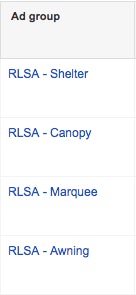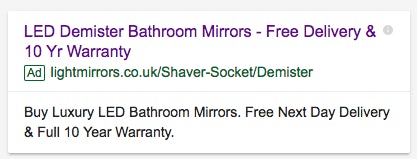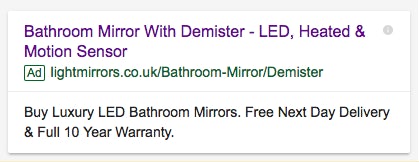Whether it’s retargeting previous website visitors with a display campaign or layering highly engaged audiences in search and shopping campaigns, we love a bit of remarketing here in the Impression PPC team. Lower CPCs, higher conversion rates: it just works, time and time again.
But there’s a lot more that advertisers could be doing when it comes to retargeting in our PPC campaigns. It’s no secret that returning visitors prove to be significantly more valuable than new visitors, whether you’re an ecommerce store or lead gen business.
In this post, I’ll explore 3 alternative uses for remarketing lists, specifically in search & shopping campaigns (RLSAs), that could help you make your retargeting strategy work harder for you.
#1 Work Some Target & Bid Magic
PPC PROBLEM:
You want to retarget users who have been on your website before, but know that those users might not necessarily search for your targeted keywords when they’re looking for relevant products or services again.
Take our promotional furniture client as an example. As choosing a quality gazebo from a reliable supplier can be a lengthy decision, a significant number of enquiries and revenue are generated up to 12-30 days after a users’ first visit to the site. Potential customers need to shop around, check out the competition, make price comparisons. By the time users are ready to convert, they probably won’t even remember the name of your brand, let alone the exact terminology you’re using in your product titles. So how do we make sure our client’s ads are there when potential customers are searching again?
RLSA SOLUTION:
In our client’s case, keywords including “tent”, “marquee” & “shelter” are all highly relevant to their products, aside from the obvious “gazebo” targeted elsewhere in campaigns. But to target these alone would likely mean high spend, low return and eventually a negative impact on quality score.

However, by layering remarketing lists with a long enough membership duration to capture longer-term returning visitors using the ‘Target and bid’ (or ‘Targeting’ in the new AdWords UI) setting, we were able to bid exclusively on these keywords that, although relevant, would never be profitable in standard search campaigns.

By doing this, we were able to show ads only to these top-of-the-funnel potential customers at a higher than average ad position, triggering their memory of our client’s brand and driving them back onto the website.
THE RESULTS:
Since the campaign was launched, it’s achieved an average ad position of 2.6 which is 10% higher than the average position reached by campaigns targeting “gazebo”-related queries. Not only that, the RLSA-only campaign achieved a ROAS that’s 121% higher than the account’s average search campaign. What’s not to love?
#2 Experiment With Similar Audiences
PPC PROBLEM:
The paid search market is becoming increasingly competitive, particularly as more and more retailers are discovering the wonders of Google Shopping. All too often, reaching new customers is leaving us with rising CPCs and campaigns limited by budget.
RLSA SOLUTION:
Similar audiences, generated automatically by AdWords once enough data has been collected in your existing remarketing lists, can be one of the most powerful ways to reach new relevant audiences at a significantly reduced cost. Google creates these by collating lists of users with similar browsing behaviour to those who have already visited your site, meaning that you’ll be left with a brand new audience of a pretty good size where Google’s already done all the prospecting work for you. Great!
When implementing this strategy for our sustainable construction client, we were able to utilise similar audiences created from several granular, high-intent remarketing lists. The more specific these audiences are the better – they’ll likely have much better CTRs and conversion rates than your typical “Similar to All Visitors” audience.

We’re all used to applying our own website remarketing lists as RLSAs to search and (more recently) shopping campaigns, but throwing similar audiences into the targeting mix can help you to increase visibility profitably: crucial in the highly competitive PPC landscape of today.
Quick tip: when adding these audiences initially, add a +0% bid adjustment to begin collecting data for the audience. Later on, once you’ve collected significant data on each targeted similar audience bid modifiers can be added to reflect their performance in each of your campaigns.
THE RESULTS:
So far, our sustainable construction client has received almost 500,000 ad impressions from similar audiences layered into shopping and search campaigns, a 5 times larger reach than remarketing lists alone. What’s more, these similar audiences achieved a conversion rate 38% higher than the account average, proving that Google’s audience prospecting really can help bring the right users into your targeting strategy.
#3 Use RLSAs In A Funnel Strategy
PPC PROBLEM:
I’d put money on the fact that at some point in everyone’s PPC career, we’ll work on an account where one or more keywords essential to the top of the conversion funnel spend more than any other in the account, achieve a low conversion rate and worse, an unprofitable ROAS. How are we supposed to get round that?
RLSA SOLUTION:
That’s where RLSAs come in. By treating the existing campaign as a “prospecting” campaign, targeting only keywords and excluding all previous website visitors and using another as the “retargeting” campaign with super-specific, segmented RLSAs layered into the keyword targeting, you’re able to reflect the conversion funnel in your campaign structure.
Based on whether targeted users are new or returning, we’re able to bid on them differently. Whilst we’re more inclined to keep bids low when new users are searching for high volume terms, we can afford to bid more competitively for the same terms when returning users search for them. By pulling users first onto the site through broad keywords and then retargeting them when they’re further along in their decision-making process, you’ll be able to have much better control over campaign performance at ad group or even keyword level.
When splitting campaigns in this way, we can even show users different ad copy depending where they are in the conversion funnel. See the examples below:
New Users:

Returning Users:

Ads shown to new users feature a more generic H2 that’s focused on delivery and warranty to attract users at their initial touch-point with our client’s brand. Meanwhile, ads for returning visitors can be heavily product-specific since we know they’ve already shopped around on-site and are much more likely to be drawn in by these products features.
THE RESULTS:
We found that after we split campaigns by new and returning visitors, CPC across all campaigns decreased almost 34% when compared to the previous period since we were able to regain control of highly competitive, high cost keywords. As a result, we also saw a 47% uplift in ROAS despite having applied often aggressive bid modifiers to increase visibility for returning users.
These three are by no means an exhaustive list of alternative uses for RLSAs, but when deployed alongside your existing campaigns, each technique can help supercharge your remarketing strategy.



